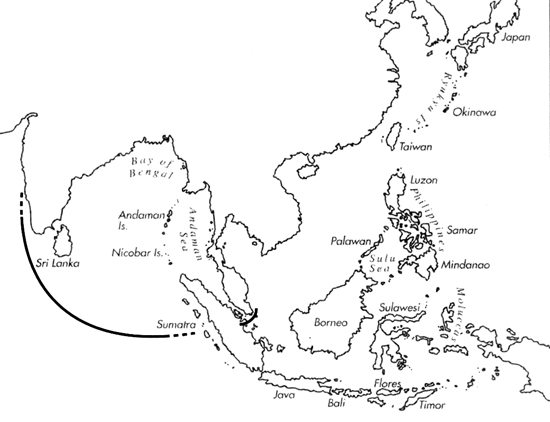
Skip Navigation Links
View access keys for this site.

Range: Nicobar Is., Sri Lanka and S. India to W. Thailand and N. Sumatra.
Description: Medium-sized to large, moderately solid to solid; forms castaneofasciata (Pl. 35, Figs. 6, 7, 9-11) and arbornatalis (Pl. 35, Fig. 8) smaller than typical shells. Last whorl ventricosely conical or conical; outline slightly convex adapically, straight below. Shoulder angulate to carinate. Spire usually of moderate height, often variably stepped, to high in form arbornatalis; outline concave, to straight in form arbornatalis. Larval shell of 2-2.25 whorls, maximum- diameter 0.9-1 mm. First 3.5-5.5 postnuclear whorls tuberculate, following whorls often carinate. Teleoconch sutural ramps concave, with 0 increasing to 5-6 spiral grooves and additional striae in late whorls. Last whorl with distinct to obsolete punctate spiral grooves from base to centre or beyond, separated by ribs at base and by ribbons above.
| Shell Morphometry | ||
|---|---|---|
| L | 50-110 mm | |
| (India 50 - 110, Andaman Sea 40 - 90, C. lozeti 56 mm) | ||
| RW | 0.25-0.66 g/mm | |
| (India 0.25 - 0.66, Andaman Sea 0.10 - 0.24) | ||
| RD | 0.54-0.70 | |
| (India 0.54 - 0.70, Andaman Sea 0.54 - 0.60, C. lozeti 0.62) | ||
| PMD | 0.78-0.90 | |
| RSH | 0.13-0.20 | |
| (form arbornatalis up to 0.33, C. lozeti 0.12) | ||
Ground colour white. Last whorl with various yellow to dark brown pattern elements: i.e., solid or interrupted, narrow to broad spiral bands of varying number; spiral lines, often articulated with white dots, spots and small tents; a variably complete network of fine lines, triangular spots, streaks and blotches bordering very small to large white tents. Elements combined in miscellaneous designs, varying from shells with plain spiral banding to shells with a delicate pattern including all elements. Larval whorls white to light brown. Postnuclear sutural ramps with yellow to dark brown radial streaks and blotches, ranging from few scattered markings to confluent markings leaving hardly any ground colour. Aperture white or bluish white to orange.
Periostracum brown, thin, translucent, and smooth.
Dorsum of foot brown, with black anterior and lateral margins; anterior part may have a black transverse band. Sole of foot reddish brown, with buff anterior and lateral edges. Siphon broad and flat, nearly white or reddish brown, with a grey transverse stripe near tip; some specimens have tan transverse lines (Kohn, 1978a & unpubl. observ.).
Radular teeth with 2 opposite adapical barbs and a fine, long serration that ends in a cusp, basal spur absent (Peile, 1939; Nybakken, 1990).
Habitat and Habits: Reported from intertidal mudflats to about 18 m, in sand (S. E. India: Satyamurti, 1952; Kohn, l978a). Form arbornatalis in 70- 1 10 m. C. lozeti: In 100- 120 m on coral sand. C. amadis feeds on molluscs.
Discussion: C. amadis resembles C. locumtenens, C. splendidulus, and C. thalassiarchus. For comparison with the last species, see its Discussion. C. lotumtenens is a somewhat smaller species without spiral grooves on postnuclear sutural ramps, with a reticulate colour pattern on the entire last whorl, without spiral lines and with brown or violet-brown deep within its aperture. C. splendidulus can be distinguished by its often heavier (RW to ca. 0.78) and less ventricose shell without pronounced spiral grooves on the sutural ramps. Its spire whorls are not carinate, its pattern lacks tents and the colour of its base is darker than that of the adjacent area. C. arbornatalis is an ecological variant from deeper water than other forms, that has a higher spire. Dautzenberg's variety names apply to colour forms: var. aurantia to yellow shells and var. castaneofasciata to shells from the Andaman Sea that are brown except for 1-2 lighter, reticulated spiral bands, at centre and sometimes below shoulder. The latter shells differ from those from India and Sri Lanka by their smaller size, somewhat narrower last whorl, and by their generally more homogeneous colour pattern. C. lozeti is known only from its holotype (Pl. 35, Figs. 12, 13). It differs from typical C. amadis mainly in the presence of a strong dentiform plate at the basal part of the columella. It has also a slightly lower spire, is shaded with rose on the last whorl and within the aperture, and its teleoconch sutural ramps lack spiral grooves. Because of the similarities to C. amadis in shell morphometry and pattern we cannot exclude that the type specimen of C. lozeti is an aberrant shell of the latter species. We therefore provisionally assign C. lozeti to C. arnadis.

C. amadis range map
This section contains verbatim reproductions of the accounts of 316 species of Conus from the Indo-Pacific region, from Manual of the Living Conidae, by Röckel, Korn and Kohn (1995). They are reproduced with the kind permission of the present publisher, Conchbooks.
All plates and figures referred to in the text are also in Röckel, Korn & Kohn, 1995. Manual of the Living Conidae Vol. 1: Indo-Pacific Region.
The range maps have been modified so that each species account has it own map, rather than one map that showed the ranges of several species in the original work. This was necessary because each species account is on a separate page on the website and not confined to the order of accounts in the book.
Return to framed version (returns to search page)